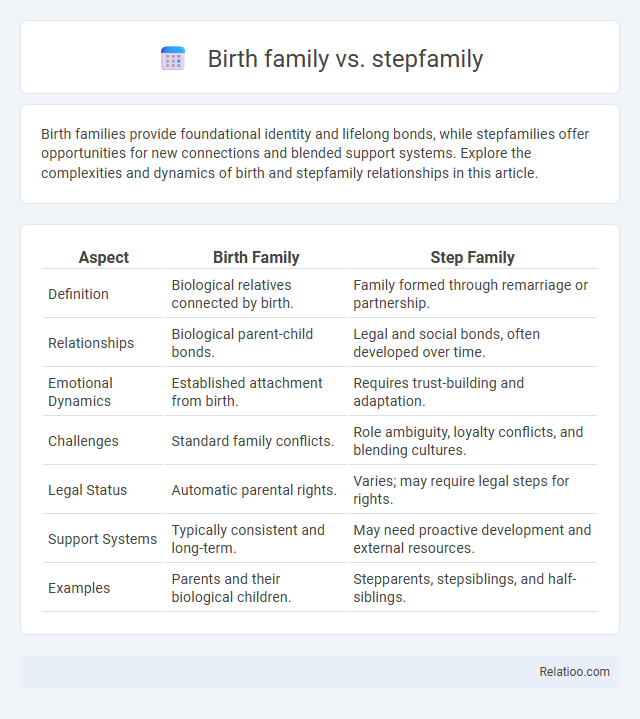Birth families provide foundational identity and lifelong bonds, while stepfamilies offer opportunities for new connections and blended support systems. Explore the complexities and dynamics of birth and stepfamily relationships in this article.
Table of Comparison
| Aspect | Birth Family | Step Family |
|---|---|---|
| Definition | Biological relatives connected by birth. | Family formed through remarriage or partnership. |
| Relationships | Biological parent-child bonds. | Legal and social bonds, often developed over time. |
| Emotional Dynamics | Established attachment from birth. | Requires trust-building and adaptation. |
| Challenges | Standard family conflicts. | Role ambiguity, loyalty conflicts, and blending cultures. |
| Legal Status | Automatic parental rights. | Varies; may require legal steps for rights. |
| Support Systems | Typically consistent and long-term. | May need proactive development and external resources. |
| Examples | Parents and their biological children. | Stepparents, stepsiblings, and half-siblings. |
Introduction to Birth Families and Step Families
Birth families consist of biological relatives who share genetic ties and early life experiences, forming the foundational support system for an individual's identity and emotional development. Step families arise through remarriage or new partnerships, integrating non-biological members and creating complex relational dynamics that can challenge traditional family roles. Loyalty conflicts often emerge as individuals navigate divided allegiances between birth and step family members, impacting emotional well-being and family cohesion.
Defining Birth Families: Structure and Dynamics
Birth families consist of biological or adoptive members connected by genetics or legal ties, forming the foundational social unit influencing individual identity. Their structure typically includes parents, siblings, and extended relatives, with dynamics shaped by shared history, roles, and emotional bonds. Understanding birth family interactions is crucial in addressing loyalty conflicts that arise when relationships with stepfamilies challenge established attachments and expectations.
Understanding Step Families: Formation and Challenges
Step families form when individuals blend separate households, creating complex relationships that differ from traditional birth families. You face unique challenges such as loyalty conflicts arising from competing attachments between birth family members and new step-relatives. Understanding these dynamics helps manage emotional tensions and fosters healthier family bonds.
Emotional Bonds in Birth Families
Emotional bonds in birth families are deeply rooted in shared genetics, history, and early life experiences, creating a foundational sense of identity and belonging. These connections often generate strong feelings of loyalty and attachment, which can lead to internal conflicts when a stepfamily introduces new relational dynamics. Navigating loyalty conflicts involves balancing respect for birth family ties with the desire to form meaningful bonds within the stepfamily unit.
Building Relationships in Step Families
Building relationships in step families requires navigating the loyalty conflict that arises between birth family ties and new family bonds. You must foster trust and open communication to create a supportive environment where all members feel respected and valued. Prioritizing empathy and patience helps bridge emotional gaps and encourages lasting connections within the blended family.
Parenting Roles: Birth Parents vs Step Parents
Parenting roles in birth families are often clearly defined by biological ties, whereas step parents must navigate establishing authority and building trust within complex family dynamics. You may face loyalty conflicts as children balance emotional bonds with birth parents while forming attachments to step parents. Effective step parenting requires patience, communication, and respect for existing family relationships to foster harmony and support children's well-being.
Navigating Conflicts and Resolutions
Navigating conflicts between birth families and stepfamilies requires understanding the unique dynamics and loyalty conflicts that arise when balancing emotional bonds. Your ability to communicate openly and set clear boundaries fosters trust and mitigates misunderstandings, while prioritizing empathy helps reconcile differing expectations within blended family structures. Effective conflict resolution often involves collaborative problem-solving and seeking external support, such as family counseling, to strengthen relationships and promote harmony.
Impact on Children: Identity and Adjustment
Children experiencing loyalty conflicts between birth and step families often face challenges in identity formation and emotional adjustment. The struggle to balance allegiance can lead to confusion, anxiety, and divided attachments, impacting their sense of belonging and self-esteem. Effective support systems and open communication are crucial for fostering resilience and helping children navigate these complex family dynamics.
Advantages and Disadvantages of Each Family Type
Birth families provide deep-rooted emotional bonds and a shared history that foster a strong sense of identity, but they may also carry unresolved conflicts and rigid expectations. Step families offer opportunities for expanded support networks and fresh relational dynamics, yet they often face challenges in establishing trust and balancing loyalty between biological and stepparents. Loyalty conflicts arise when individuals feel torn between birth and stepfamily obligations, causing emotional stress but also encouraging personal growth through reconciliation and boundary-setting.
Tips for Strengthening Family Connections
Strengthening family connections amid birth family, stepfamily, and loyalty conflicts requires fostering open communication and setting clear boundaries to respect all relationships involved. Encourage empathy and understanding by validating each member's feelings and history, which helps bridge gaps between biological ties and new family dynamics. Regular family activities and counseling can build trust, promote unity, and resolve divided loyalties effectively.

Infographic: Birth family vs Step family
 relatioo.com
relatioo.com